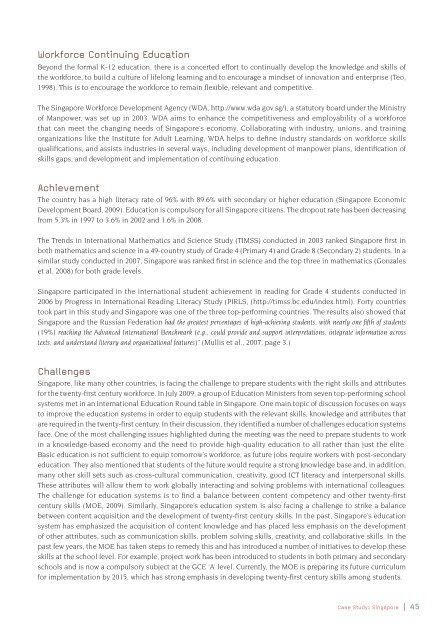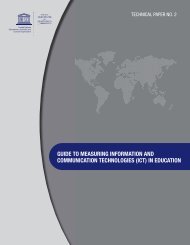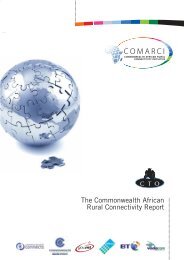Transforming education: the power of ICT policies - Commonwealth ...
Transforming education: the power of ICT policies - Commonwealth ...
Transforming education: the power of ICT policies - Commonwealth ...
You also want an ePaper? Increase the reach of your titles
YUMPU automatically turns print PDFs into web optimized ePapers that Google loves.
Workforce Continuing Education<br />
Beyond <strong>the</strong> formal K-12 <strong>education</strong>, <strong>the</strong>re is a concerted effort to continually develop <strong>the</strong> knowledge and skills <strong>of</strong><br />
<strong>the</strong> workforce, to build a culture <strong>of</strong> lifelong learning and to encourage a mindset <strong>of</strong> innovation and enterprise (Teo,<br />
1998). This is to encourage <strong>the</strong> workforce to remain fl exible, relevant and competitive.<br />
The Singapore Workforce Development Agency (WDA, http://www.wda.gov.sg/), a statutory board under <strong>the</strong> Ministry<br />
<strong>of</strong> Man<strong>power</strong>, was set up in 2003. WDA aims to enhance <strong>the</strong> competitiveness and employability <strong>of</strong> a workforce<br />
that can meet <strong>the</strong> changing needs <strong>of</strong> Singapore’s economy. Collaborating with industry, unions, and training<br />
organizations like <strong>the</strong> Institute for Adult Learning, WDA helps to defi ne industry standards on workforce skills<br />
qualifi cations, and assists industries in several ways, including development <strong>of</strong> man<strong>power</strong> plans, identifi cation <strong>of</strong><br />
skills gaps, and development and implementation <strong>of</strong> continuing <strong>education</strong>.<br />
Achievement<br />
The country has a high literacy rate <strong>of</strong> 96% with 89.6% with secondary or higher <strong>education</strong> (Singapore Economic<br />
Development Board, 2009). Education is compulsory for all Singapore citizens. The dropout rate has been decreasing<br />
from 5.3% in 1997 to 3.6% in 2002 and 1.6% in 2008.<br />
The Trends in International Ma<strong>the</strong>matics and Science Study (TIMSS) conducted in 2003 ranked Singapore fi rst in<br />
both ma<strong>the</strong>matics and science in a 49-country study <strong>of</strong> Grade 4 (Primary 4) and Grade 8 (Secondary 2) students. In a<br />
similar study conducted in 2007, Singapore was ranked fi rst in science and <strong>the</strong> top three in ma<strong>the</strong>matics (Gonzales<br />
et al. 2008) for both grade levels.<br />
Singapore participated in <strong>the</strong> international student achievement in reading for Grade 4 students conducted in<br />
2006 by Progress in International Reading Literacy Study (PIRLS, (http://timss.bc.edu/index.html). Forty countries<br />
took part in this study and Singapore was one <strong>of</strong> <strong>the</strong> three top-performing countries. The results also showed that<br />
Singapore and <strong>the</strong> Russian Federation had <strong>the</strong> greatest percentages <strong>of</strong> high-achieving students, with nearly one fi fth <strong>of</strong> students<br />
(19%) reaching <strong>the</strong> Advanced International Benchmark (e.g., could provide and support interpretations, integrate information across<br />
texts, and understand literary and organizational features)” (Mullis et al., 2007, page 3.)<br />
Challenges<br />
Singapore, like many o<strong>the</strong>r countries, is facing <strong>the</strong> challenge to prepare students with <strong>the</strong> right skills and attributes<br />
for <strong>the</strong> twenty-fi rst century workforce. In July 2009, a group <strong>of</strong> Education Ministers from seven top-performing school<br />
systems met in an International Education Round table in Singapore. One main topic <strong>of</strong> discussion focuses on ways<br />
to improve <strong>the</strong> <strong>education</strong> systems in order to equip students with <strong>the</strong> relevant skills, knowledge and attributes that<br />
are required in <strong>the</strong> twenty-fi rst century. In <strong>the</strong>ir discussion, <strong>the</strong>y identifi ed a number <strong>of</strong> challenges <strong>education</strong> systems<br />
face. One <strong>of</strong> <strong>the</strong> most challenging issues highlighted during <strong>the</strong> meeting was <strong>the</strong> need to prepare students to work<br />
in a knowledge-based economy and <strong>the</strong> need to provide high-quality <strong>education</strong> to all ra<strong>the</strong>r than just <strong>the</strong> elite.<br />
Basic <strong>education</strong> is not suffi cient to equip tomorrow’s workforce, as future jobs require workers with post-secondary<br />
<strong>education</strong>. They also mentioned that students <strong>of</strong> <strong>the</strong> future would require a strong knowledge base and, in addition,<br />
many o<strong>the</strong>r skill sets such as cross-cultural communication, creativity, good <strong>ICT</strong> literacy and interpersonal skills.<br />
These attributes will allow <strong>the</strong>m to work globally interacting and solving problems with international colleagues.<br />
The challenge for <strong>education</strong> systems is to fi nd a balance between content competency and o<strong>the</strong>r twenty-fi rst<br />
century skills (MOE, 2009). Similarly, Singapore’s <strong>education</strong> system is also facing a challenge to strike a balance<br />
between content acquisition and <strong>the</strong> development <strong>of</strong> twenty-fi rst century skills. In <strong>the</strong> past, Singapore’s <strong>education</strong><br />
system has emphasized <strong>the</strong> acquisition <strong>of</strong> content knowledge and has placed less emphasis on <strong>the</strong> development<br />
<strong>of</strong> o<strong>the</strong>r attributes, such as communication skills, problem solving skills, creativity, and collaborative skills. In <strong>the</strong><br />
past few years, <strong>the</strong> MOE has taken steps to remedy this and has introduced a number <strong>of</strong> initiatives to develop <strong>the</strong>se<br />
skills at <strong>the</strong> school level. For example, project work has been introduced to students in both primary and secondary<br />
schools and is now a compulsory subject at <strong>the</strong> GCE ‘A’ level. Currently, <strong>the</strong> MOE is preparing its future curriculum<br />
for implementation by 2015, which has strong emphasis in developing twenty-fi rst century skills among students.<br />
Case Study: Singapore | 45
















